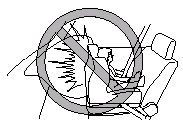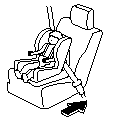Child Restraint Precautions
Mazda strongly urges the use of child-restraint systems for children small
enough to use
them.
You are required by law to use a child-restraint system for children in the U.S. and Canada.
Check your local and state or provincial laws for specific requirements
regarding the safety
of children riding in your vehicle.
Whatever child-restraint system you consider, please pick the appropriate one
for the age
and size of the child, obey the law and follow the instructions that come with
the individual
child-restraint system.
A child who has outgrown child-restraint systems should sit in the rear and use
seat belts,
both lap and shoulder. If the shoulder belt crosses the neck or face, move the
child closer to
the center of the vehicle in the outboard seats, and towards the buckle on the
right if the
child is seated on the center seat.
Statistics confirm that the rear seat is the best place for all children up to
12 years of age,
and more so with a supplemental restraint system (air bags).
A rear-facing child-restraint system should NEVER be used on the front seat with
the air
bag system activated. The front passenger's seat is also the least preferred
seat for other
child-restraint systems.
To reduce the chance of injuries caused by deployment of the front passenger air
bag, your
vehicle is equipped with the front passenger seat weight sensors. These sensors
deactivate
the front passenger front and side air bags and also the front passenger seat
belt
pretensioner system when the total seated weight on the front passenger seat is
less than
approximately 30 kg (66 lb).
When an infant or small child sits on the front passenger seat, the system shuts
off the front
passenger air bag, so make sure the front passenger air bag deactivation
indicator light
illuminates.
Even if the front passenger air bag is shut off, Mazda strongly recommends that
children be
properly restrained and child-restraint systems of all kinds are properly
secured on the rear
seats which are the best place for children.
For more details, refer to “Front passenger seat weight sensors”.
WARNING:
Use the correct size child-restraint system:
For effective protection in vehicle accidents and sudden stops, a child must be
properly restrained using a seat belt or child-restraint system depending on age
and
size. If not, the child could be seriously injured or even killed in an
accident.
Follow the manufacturer's instructions and always keep the child-restraint
system
buckled down:
An unsecured child-restraint system is dangerous. In a sudden stop or a
collision it
could move causing serious injury or death to the child or other occupants. Make
sure any child-restraint system is properly secured in place according to the
childrestraint
system manufacturer's instructions. When not in use, remove it from the
vehicle or fasten it with a seat belt, or latch it down to BOTH LATCH lower
anchors
for LATCH child-restraint systems, and attach the corresponding tether anchor.
Always secure a child in a proper child-restraint system:
Holding a child in your arms while the vehicle is moving is extremely dangerous.
No
matter how strong the person may be, he or she cannot hold onto a child in a
sudden stop or collision and it could result in serious injury or death to the
child or
other occupants. Even in a moderate accident, the child may be exposed to air
bag
forces that could result in serious injury or death to the child, or the child
may be
slammed into an adult, causing injury to both child and adult.

Never use a rear-facing child-restraint system in the front seat with an
air bag that
could deploy:
Rear-facing child-restraint systems on the front seat are particularly
dangerous.
The child-restraint system can be hit by a deploying air bag and moved violently backward resulting in serious injury or death to the child.

Do not install a front-facing child-restraint system on the front
passenger seat unless
it is unavoidable:
In a collision, the force of a deploying air bag could cause serious injury or
death to
the child. If installing a front-facing child-restraint system on the front
passenger
seat is unavoidable, move the front passenger seat as far back as possible.
Seating a child in a child-restraint system on the front passenger seat is
dangerous:
Your vehicle is equipped with front passenger seat weight sensors. Even with
front
passenger seat weight sensors, if you must use the front passenger seat to seat
a
child, using a child-restraint system on the front passenger seat under the
following
conditions increases the danger of the front passenger air bag deploying and
could
result in serious injury or death to the child.
 The total seated weight of the child with the child-restraint system on the
The total seated weight of the child with the child-restraint system on the
front
passenger seat is approximately 30 kg (66 lb) or more with a child in the
childrestraint
system.
 Luggage or other items are placed on the seat with the child in the
Luggage or other items are placed on the seat with the child in the
child-restraint
system.
 A rear passenger or luggage pushing or pulling down on the front passenger
A rear passenger or luggage pushing or pulling down on the front passenger
seatback.
 A rear passenger puts their feet on the front seat rails.
A rear passenger puts their feet on the front seat rails.
 Luggage or other items are placed on the seatback or hung on the head
Luggage or other items are placed on the seatback or hung on the head
restraint.
 Heavy items are placed in the seatback map pocket.
Heavy items are placed in the seatback map pocket.
 The seat is washed.
The seat is washed.
 Liquids are spilled on the seat.
Liquids are spilled on the seat.
 The front passenger seat is moved backward, pushing into luggage or other
The front passenger seat is moved backward, pushing into luggage or other
items
placed behind it.
 The front passenger seatback contacts the rear seat.
The front passenger seatback contacts the rear seat.
 Luggage or other items are placed between the front passenger seat and driver
Luggage or other items are placed between the front passenger seat and driver
seat.
 Any accessories increasing the total seated weight on the front passenger seat
Any accessories increasing the total seated weight on the front passenger seat
are
attached to the front passenger seat.
The designated positions with seat belts on the rear seats are the safest places
for
children. Always use seat belts and child restraints.
Do not allow a child or anyone to lean over or against the side window of a
vehicle
with side and curtain air bags:
It is dangerous to allow anyone to lean over or against the side window, the
area of
the front passenger seat, the front and rear window pillars and the roof edge
along
both sides from which the side and curtain air bags deploy, even if a
child-restraint
system is used. The impact of inflation from a side or curtain air bag could
cause
serious injury or death to an out of position child. Furthermore, leaning over
or
against the front door could block the side and curtain air bags and eliminate
the
advantages of supplemental protection. With the front air bag and the additional
side air bag that comes out of the front seat, the rear seat is always a better
location
for children. Take special care not to allow a child to lean over or against the
side
window, even if the child is seated in a child-restraint system.
Never use one seat belt on more than one person at a time:
Using one seat belt for more than one person at a time is dangerous. A seat belt
used in this way cannot spread the impact forces properly and the two passengers
could be crushed together and seriously injured or even killed. Never use one
belt for
more than one person at a time and always operate the vehicle with each occupant
properly restrained.
CAUTION:
A seat belt or child-restraint system can become very hot in a closed vehicle
during
warm weather. To avoid burning yourself or a child, check them before you or
your
child touches them.
NOTE:
Your Mazda is equipped with LATCH lower anchors for attachment of specially
designed LATCH
child-restraint systems in the rear seat. When using these anchors to secure a
child-restraint system,
refer to “LATCH Child-Restraint Systems”.
See also:
Convenient Use of the Hands-Free System
qPhone book usage
Phone book registration
Phone numbers can be registered to the
Bluetooth Hands-Free phone book.
NOTE:
Do this function only when parked. It is too
distracting to attempt while ...
Windshield Wipers
Turn the wipers on by pulling the lever
down.
INT ― Intermittent
LO ― Low speed
HI ― High speed
For a single wiping cycle, push the lever
up to MIST.
MIST ― Mist
Wind ...
Brake/Clutch Fluid
Inspecting Brake/Clutch Fluid Level
The brakes and clutch draw fluid from the
same reservoir.
Inspect the fluid level in the reservoir
regularly. It should be kept at MAX.
The level normally dr ...


